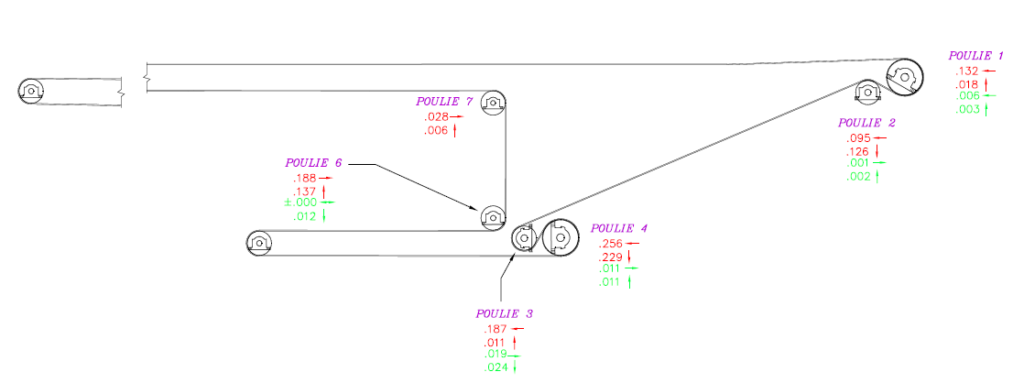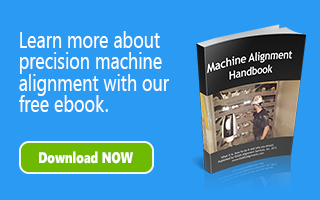Having a reliable and long-lasting conveyor system is key to a mining operation. However, alignment of conveyors is often overlooked and the reliability of these conveyors is undermined. Common conveyor issues caused by misalignment include belt failure and premature pulley wrapping and/or pulley bearing failure. Any of these problems will cause the extremely costly halt of production and emergency reparation. Regular preventive alignment inspections help to reduce these costs and improve operating efficiency.
Due to the nature of mining operations, many conveyors were erected as temporary installations. As a result, most pulley bearing mounting plates were simply a piece of steel plate welded onto the structure of the conveyor frame. The flatness of these mounting plates is often marginal due to welding and in most cases, the two bearing mounting plates are not coplanar.

Drawing shows non coplanar mounting plates – front view and elevation view. Colored lines represent the two plates.
The lack of flatness can create a great deal of stress in the bearing housing once the bearing housing is bolted down onto the mounting plate. Deformity occurs as the bearing housing begins to take the form of the plates. This angle between the mounting plates increases the difficulty to align the pulley and the gap of the bearing sealing. To correct this alignment problem, an OASIS metrology engineer begins by using a Leica AT960 laser tracker to survey the mounting plate surface in order to shim the plates. This is done to create a pair of flat, coplanar mounting surfaces that are either level to earth or square to the conveyor centerline depending on the orientation of the mounting plates. After correcting the alignment, the results typically include less vibration, reduced bearing failure and a reduction in the frequency of bearing changes.
Another major issue that can occur in a conveyor system is pulley misalignment, which can lead to belt tracking problems and pulley wrapping failure. Pulley alignment is often overlooked in mining operations due to belt length and flexibility. When a new pulley is installed, they are often leveled with a construction level and aligned to the frame locally with a tape measure at best. Since the frame of the conveyor is often constructed by welding I-beams together, the straightness and squareness of the frame is not always ideal. This can cause severe belt tracking issues and at times, the belt could be rubbing the conveyor frame even with the guide pulley working hard to correct it. The tension differential cause by the misalignment can also cause the pulley wrapping to fail prematurely. To correct the misalignment, an OASIS metrology engineer using a laser tracker, would begin by surveying the conveyor frame centerline over the distance of at least 100ft. By doing this, the metrology engineer can average out any possible random errors created by bent frame or rough surface and establish an average centerline as parallel as possible to the belt run. The pulleys are then aligned to this average centerline and level to earth. After correcting pulley misalignment, mining operations can often achieve longer pulley and belt life.

Drawing shows conveyor pulley data before alignment and the improvement seen after alignment was completed.
Real World Example
On multiple occasions, a mining operation in Canada had to halt production due to premature bearing failure on one of their conveyors. This caused significant production loss due to the downtime needed to replace the broken bearings. OASIS was brought in to inspect the conveyor system and severe pulley misalignment was discovered. After OASIS completed the inspection and corrected the conveyor pulley alignment issues, the bearing failures have been eliminated – leading to longer uptime. Having observed such an improvement in production, the mine now uses OASIS metrology services on every shutdown. The mine concluded that preventive inspection is an inexpensive solution when compared to the costs associated with regularly halting production and replacing bearings.
This post was co-authored by OASIS Metrology Engineers, Li Guan and Catherine St-Laurent. Both Li and Catherine are located in OASIS Canadian Service Center in Montréal, QC and travel to customer locations across Canada and the U.S.
Li Guan began his career with OASIS in 2011. Li is an expert in 3D metrology tooling and methodologies and this experience combined with an exceptional commitment to customer service, makes him a highly sought after resource for metrology solutions in many industries including aerospace, mining, pulp and paper, converting, fabrication and more. Li obtained a Bachelor of Engineering (Mechanical) degree in 2010 from McGill University in Montréal, QC. Li can be reached at 514.333.0400 ex 228 or li.guan@oasisalignment.com.
Catherine St-Laurent joined OASIS in 2016. In the past year, Catherine has been in the field refining her metrology skills and gaining experience in industries such as aerospace, mining, converting and pulp and paper. She is dedicated to providing the level of service our customers rely on and has become an integral part of the OASIS team. Catherine obtained a Bachelor of Engineering (Mechanical, Co-op) degree in 2015 from Concordia University in Montréal, QC. She can be reached at 514.333.0400 ex 229 or catherine.st-laurent@oasisalignment.com.

